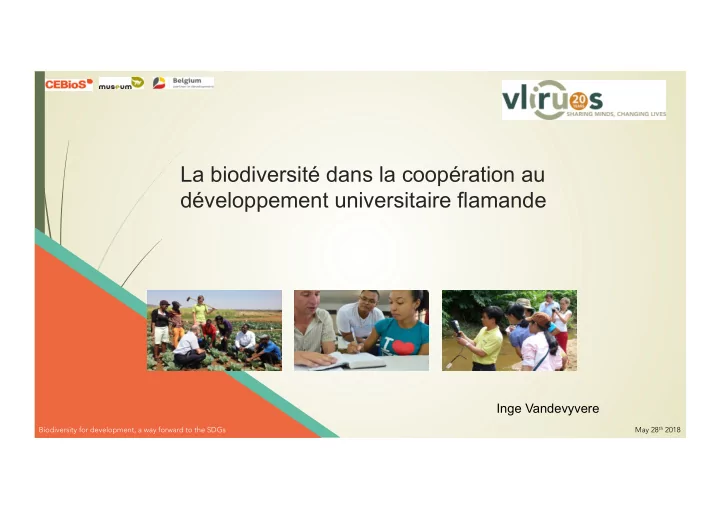

La biodiversité dans la coopération au développement universitaire flamande Inge Vandevyvere Biodiversity for development, a way forward to the SDGs May 28 th 2018
The role of universities in development – VLIR-UOS model Higher Education Institutions contribute to sustainable development ? ? ? ? Higher Education Institutions empowered in their Individuals empowered as role as drivers of change change agents Education & scholarships Projects & programmes New knowledge, New Training & Improved Improved applications or services knowledge & Master Research Education created + UPTAKE skills programmes Capacity development of Flemish HEI to create the conditions for university cooperation for development
Biodiversité dans les programmes • 2017 • Appel à propositions 2018 May 28 th 2018 Biodiversity for development, a way forward to the SDGs
Bridging social innovation and just conservation in the quest for sustainable socio-ecological development Prof. Constanza Parra Department of Earth & Environmental Sciences, KU Leuven “Colloquium Biodiversity for Development, a way forward to the SDGs” Cebios - Royal Belgian Institute of Natural Sciences Brussels, 28 May 2018
What does the research on protected areas and conservation say? 5 PAs as a history of success and human progress (Sulton & Dudley, 2010) � source of entire well-being: health, recreation, purity of water, food stores, hazard mitigation, biodiversity conservation, cultural diversity, role in mitigating/controlling climate change, peace, education, sustainability, ecosystem services… PAs as a tragic record of failure (Brockington et al., 2008; Fairhead et al. 2012) � Gap between values and practices: powerless regarding capitalism forces; instrument of neoliberal policies; disempowerment of rural/ indigenous groups; conservation-induced displacement, nature/land grabbing (Political ecology, environmental justice, environmental sociology)
The governance of protected areas for biodiversity conservation � Conservation and governance of PAs have always been difficult , and a source of conflicts between different actors, interests and development alternatives. � Governance of conservation has changed along history, since the foundation of the first national parks till today. There is a variety of mechanisms (and fashions, discourses) for conservation: � National parks (central state) � Regional/municipal parks (other public authorities) � Community-based conservation (local communities, indigenous groups,..) � Payment for Ecosystem Services i.e. REDD+ (market-based/inspired approaches)
The governance of PAs for biodiversity conservation: A plea for bridging societal and ecological needs � Conservation targets and urgency will keep on growing (climate change, biodiversity, urbanisation, uncontrolled extractivism…) � Who will make the efforts? � Who will pay the costs? � Whose needs will be prioritized? A plea for bridging societal and ecological needs
Bridging social innovation and just conservation in the quest for sustainable socio-ecological development Socio-ecological development in PAs Key questions Multi-scalar analysis of the • What is socially sustainable • socio-political, economic, & fair when it comes to cultural environments in which 1. Research biodiversity conservation? 2. Concepts & conservation efforts unfold problematique How to accommodate theory • (spatial and temporal scales): conservation goals with From just Complex & unfavourable; • Governance of socio- those of a sustainable socio- conservation to Social innovation for ecological • ecological development sustainable socio- sustainable socio- development, ecological ones? environmental justice, ecological development development of PAs political ecology, (Aichi + SDGs) social innovation Inter/transdisciplinary action 4. Goals, 3. Methodological Empowering and inclusive research challenges and approach & capacity building Inclusive, participatory and • outcomes in terms research methods - Building mutual trust sensitive to local needs of capacity - Co-production of knowledge Inter-/ Involvement of a diverse mix • building transdisciplinarity (inclusive, critical, creative) of stakeholders Empowerment at - Hierarchies and power Co-design of research Inclusive participatory • partner universities asymmetries within social action research questions, methods, analyses, and community levels groups (interculturality, policy recommendations (i.e. gender, language,…) participatory mapping, - bottom- linked social participatory workshops, innovation. interculturality, power dynamics, etc.)
Sustainable rural development through community-based and bottom-linked ecotourism in the Chaparri Nature Reserve Region, North of Peru (VLIR-UOS SI, 2017-2018) Constanza Parra*, Pieter van den Broeck*, Marcia Iberico**, Elke Hermans***, Heider Escalante** (* KUL, BE, ** UNT, PE *** HU, BE)
Triggering sustainable development and indigenous social inclusion through community-based REDD+ in the Peruvian Amazon (VLIR-UOS TEAM, 2018-2021) Constanza Parra*, Pieter van den Broeck*, Deborah Delgado**, Alfredo Quinteros***, Alberto Garcia Ruiz****, Liliana Lozano * + ** (*KUL, BE, **PUCP, PE, *** UNSM, PE, **** UNAP, PE)
Inclusive Rural Development through social innovation in land access and governance initiatives in Nicaragua (VLIR- UOS TEAM, 2018-2021) Pieter van den Broeck*, Constanza Parra*, Pierre Merlet**, Johan Bastiaensen***, Carmen Collado (*KUL, BE, ** Nitlapan UCA, NI, *** UA, BE)
Final reflections on the way to the SDGs On the need to understand biodiversity conservation efforts and struggles within a larger quest for sustainable socio- ecological development � It is not only about biodiversity but also about the variety of communities who use, access, transform, inhabit, exploit, harm, take care of and love these places. � The challenge of biodiversity conservation is about: (1) Justice, equity and inclusion, and (2) Bottom-linked social innovation. � SDGs and Aichi Targets not as individual parcels but in their dynamic synergetic potential. � The roles of action research for a socially innovative capacity building: � Inter/transdisciplinarity � Inclusive, participatory and sensitive to local needs � Empowerment of academic and non-academic communities (i.e. empowerment through research-driven education)
Recommend
More recommend